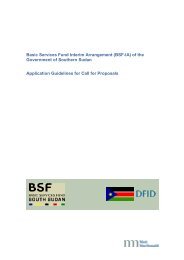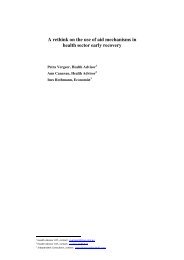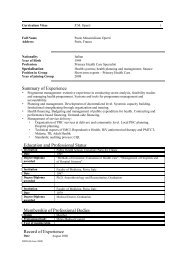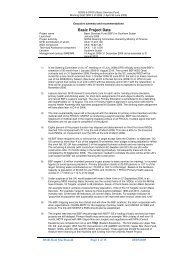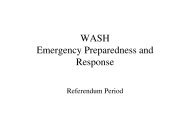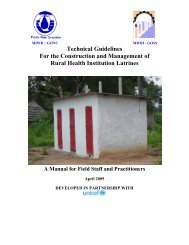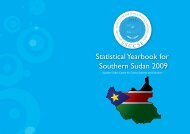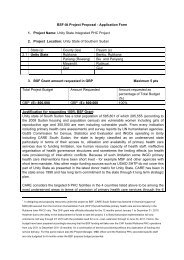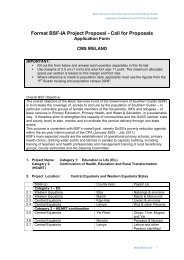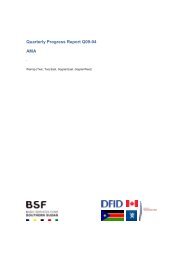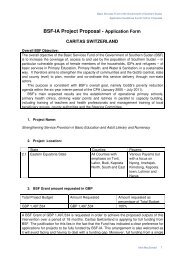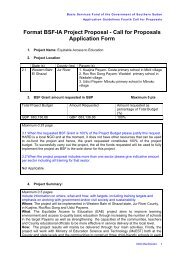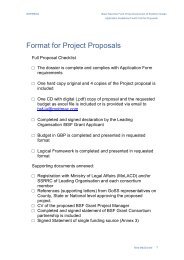Audit requirements - Basic Services Fund SOUTH SUDAN
Audit requirements - Basic Services Fund SOUTH SUDAN
Audit requirements - Basic Services Fund SOUTH SUDAN
Create successful ePaper yourself
Turn your PDF publications into a flip-book with our unique Google optimized e-Paper software.
<strong>Basic</strong> <strong>Services</strong> <strong>Fund</strong> Interim ArrangementDFID & Government of Southern SudanExpenditure VerificationTerms of ReferenceTerms of Referencefor the<strong>Audit</strong> of project expenditures of a DFID/BMB MoTTMacDonald Grant contractTABLE OF CONTENTS1. Terms of reference1.1 Responsibilities of the Parties to the Engagement1.2 Subject of the Engagement1.3 Reason for the Engagement1.4 Engagement Type and Objective1.5 Scope of Work1.6 Reporting1.7 Other TermsANNEX 1 Scope of Work and Procedures to be performed:1. Obtaining a sufficient understanding of the project and ofthe Terms and Conditions of the Grant Contract2. Procedures to verify the eligibility of expenditure claimedby the beneficiary in the Financial Report for the project2.1 General procedures2.2 Conformity of expenditure with the Budget andAnalytical review2.3 Selecting expenditure for verification2.4 Verification of expenditure2.5 Verification coverage of expenditure3. Procedures to verify the working and quality of internalcontrol systemsANNEX 2 Report of factual findings for an expenditureverification of a DFID financed Grant contractANNEX 3 Management LetterPage 2 of 15 BMB Mott MacDonald 15 December 2010
<strong>Basic</strong> <strong>Services</strong> <strong>Fund</strong> Interim ArrangementDFID & Government of Southern SudanExpenditure VerificationTerms of Reference1. Terms of referenceThe following are the terms of reference (ToR) on which ‘the Beneficiary’ agrees to engage < name of the audit firm>‘the <strong>Audit</strong>or’ to perform an audit of financial expenditure verification and toreport in connection with the DFID/BMB Mott MacDonald financed Grantcontract concerning < title and number of the grant contract> (the ‘GrantContract’). ‘Contracting Authority’ refers to whichhas signed the Grant Contract with the Beneficiary and is providing the grantfunding. The Contracting Authority is not a party to this engagement.1.1 Responsibilities of the Parties to the Engagement‘The Beneficiary’ refers to the organisation that is receiving the grantand that has signed the Grant Contract with the ContractingAuthority.• The Beneficiary is responsible for providing a Financial Report forthe Project financed by the Grant Contract and for ensuring thatthis Financial Report can be reconciled with the Beneficiary’saccounting and bookkeeping system and to the underlyingaccounts and records.• The Beneficiary accepts that the ability of the <strong>Audit</strong>or to performthe procedures required by this engagement effectively dependsupon the Beneficiary, and as the case may be their partners,providing full and free access to the Beneficiary’s staff and itsaccounting and other records, including all relevant contractdocumentation and communication.‘The <strong>Audit</strong>or’ refers to the <strong>Audit</strong>or who is responsible for followingthe agreed-upon procedures as specified in these ToR, and forsubmitting a report of factual findings to the Beneficiary.• [Option 1: delete if not applicable] The <strong>Audit</strong>or is a member of which in turn is amember of the International Federation of Accountants (IFAC).• [Option 2: delete if not applicable] The <strong>Audit</strong>or is a member of. Although thisorganisation is not member of the IFAC, the <strong>Audit</strong>or commitshimself to undertake this engagement in accordance withapplicable IFAC standards and ethics.1.2 Subject of the EngagementThe subject of this engagement is the Financial Report in connectionwith the Grant Contract for the period covering .Page 3 of 15 BMB Mott MacDonald 15 December 2010
<strong>Basic</strong> <strong>Services</strong> <strong>Fund</strong> Interim ArrangementDFID & Government of Southern SudanExpenditure VerificationTerms of ReferenceThe information, both financial and non-financial, which is subject toverification by the <strong>Audit</strong>or, is all information which makes it possible to- verify that the expenditure, as claimed by the Beneficiary in theFinancial Report, has occurred, is accurate and eligible, and- review the internal control procedures maintained and report on anydeficiencies identified.Annex 1 to these ToR contains an overview of key information aboutthe Grant Contract and the Project concerned.Chapter 1 of the Expenditure Verification Report contains a summary ofthe Grant contract and project.1.3 Reason for the EngagementThe Beneficiary is required to submit to the Contracting Authority aninterim expenditure verification report, including a management letterand a final expenditure verification report, including a managementletter produced by an external auditor in support of the paymentrequested by the Beneficiary.1.4 Engagement Type and ObjectiveThis constitutes an engagement to perform specific agreed-uponprocedures regarding an expenditure verification of a DFID financedgrant contract. The objective of this expenditure verification is for the<strong>Audit</strong>or to verify that the expenditure claimed by the Beneficiary in theFinancial Report for the Project financed by the Grant Contract hasoccurred (‘reality’), is accurate (‘exact’) and eligible and to submit tothe Beneficiary a report of factual findings with regard to the agreeduponprocedures performed. Eligibility means that the funds providedby the grant have been spent in accordance with the terms andconditions of the Grant Contract.As this engagement is not an assurance engagement the <strong>Audit</strong>or, doesnot provide an audit opinion and expresses no assurance. TheContracting Authority derives its assurance by drawing its ownconclusions from the factual findings reported by the <strong>Audit</strong>or on theFinancial Report and the payment request of the Beneficiary relatingthereto.1.5 Scope of Work1.5.1 The <strong>Audit</strong>or shall undertake this engagement in accordance with theseToR and in:accordance with the International Standard on Related <strong>Services</strong>(‘ISRS’) 4400 Engagements to perform Agreed-upon Proceduresregarding Financial Information as promulgated by the IFAC;Page 4 of 15 BMB Mott MacDonald 15 December 2010
<strong>Basic</strong> <strong>Services</strong> <strong>Fund</strong> Interim ArrangementDFID & Government of Southern SudanExpenditure VerificationTerms of Referenceundertake follow-up measures for correction and improvementfor the remaining implementation period of the Project.2.1.3 The <strong>Audit</strong>or reconciles the information in the Financial Report to theBeneficiary’s accounting system and records (e.g. trial balance,general ledger accounts, sub ledgers etc.).2.1.4 The <strong>Audit</strong>or verifies that the correct exchange rates have been appliedfor currency conversions where applicable and in accordance with theconditions of the Grant Contract.2.2 Conformity of Expenditure with the Budget and Analytical ReviewThe <strong>Audit</strong>or carries out an analytical review of the expenditure headingsin the Financial Report and verifies that:the budget in the Financial Report corresponds with the Budgetof the Grant Contract (authenticity and authorisation of theinitial Budget) and that expenditure incurred was foreseen in thebudget of the Grant Contract.the total amount claimed for payment by the Beneficiary doesnot exceed the maximum grant laid down in Article 3.2 of theSpecial Conditions of the Grant Contract.amendments to the Budget of the Grant Contract comply withthe conditions for such amendments (including where applicablethe requirement for an addendum to the Grant Contract).2.3 Selecting Expenditure for Verification2.3.1 Expenditure Headings, Subheadings and ItemsThe expenditure claimed by the Beneficiary in the Financial Report ispresented under the following budget headings:1 Human Resources,2 Travel,3 Equipment and Supplies,4 Project and base office running cost,5 Direct service delivery costs,6 Other costs,8 Administrative costs and9 Professional audit feesExpenditure headings can be broken down into expendituresubheadings such as for example 1.1 Salaries.Expenditure subheadings can be broken down into individualexpenditure items or classes of expenditure items with the same orsimilar characteristics. Supporting evidence (e.g. a payment, acontract, an invoice etc) and the way expenditure is recorded (e.g.journal entries) can vary with type and nature of the expenditure andthe underlying transactions. In all cases expenditure items reflect thePage 7 of 15 BMB Mott MacDonald 15 December 2010
<strong>Basic</strong> <strong>Services</strong> <strong>Fund</strong> Interim ArrangementDFID & Government of Southern SudanExpenditure VerificationTerms of Referenceaccounting (or financial) value of underlying actions or transactions nomatter the type and nature of the action or transaction concerned.2.3.2 Selecting Expenditure ItemsValue should be the primary factor used by the <strong>Audit</strong>or to selectexpenditure items or classes of expenditure items for verification. The<strong>Audit</strong>or selects high value expenditure items to ensure an appropriatecoverage of expenditure to obtain adequate ground for a considerationof the eligibility of the total expenditure and of the quality and theworking of the internal control measures.Selection of specific expenditure items or classes of expenditure itemsis based on <strong>Audit</strong>or’s judgement. The <strong>Audit</strong>or may use factors such asparticular knowledge of the Project and the characteristics of theexpenditure categories, classes and items being verified such as forexample expenditure items that are unusual or inherently risky or errorprone.2.4 Verification of ExpenditureThe <strong>Audit</strong>or verifies the expenditure and reports all the exceptionsresulting from this verification. Verification exceptions are allverification deviations found when performing the procedures set out inthis Annex. In all cases the <strong>Audit</strong>or assesses the (estimated) financialimpact of exceptions in terms of ineligible expenditure. The <strong>Audit</strong>orreports all exceptions found including the ones of which he cannotmeasure the financial impact. Having selected the expenditure itemsthe <strong>Audit</strong>or verifies them by testing for the criteria set out below.2.4.1 Eligibility of Direct CostsThe <strong>Audit</strong>or verifies the eligibility of direct costs with the terms andconditions of the Grant Contract. S/he verifies that these costs:- are necessary for carrying out the Project. In other words the<strong>Audit</strong>or verifies that expenditure for a transaction or action has beenincurred for the intended purpose of the Project and that is hasbeen necessary for the activities and objectives of the Project. The<strong>Audit</strong>or further verifies that the direct costs are provided for in theGrant Contract Budget and comply with the principles of soundfinancial management, in particular value for money and costeffectiveness;- have actually been incurred by the Beneficiary or his partners duringthe implementation period of the Project;- are recorded in the accounts of the Beneficiary and are identifiable,verifiable and substantiated by originals of supporting evidence.The <strong>Audit</strong>or also considers non-eligible costs.2.4.2 Accuracy and RecordingThe <strong>Audit</strong>or verifies that expenditure for a transaction or action hasbeen accurately and properly recorded in the Beneficiary’s accountingsystem and the Financial Report and that it is supported by appropriateevidence and supporting documents. This includes proper valuation andPage 8 of 15 BMB Mott MacDonald 15 December 2010
<strong>Basic</strong> <strong>Services</strong> <strong>Fund</strong> Interim ArrangementDFID & Government of Southern SudanExpenditure VerificationTerms of Referencethe use of correct exchange rates.2.4.3 ClassificationThe <strong>Audit</strong>or verifies that expenditure for a transaction or action hasbeen classified under the correct heading and subheading of theFinancial Report.2.4.4 Reality (occurrence/existence)The <strong>Audit</strong>or exercises professional judgment to obtain sufficientappropriate verification evidence as to whether the expenditure hasoccurred (reality and quality of the expenditure) and - where applicable- assets exist. The <strong>Audit</strong>or verifies the reality and quality of theexpenditure for a transaction or action by examining proof of workdone, goods received or services rendered on a timely basis, atacceptable and agreed quality and at reasonable prices or costs.2.4.5 Administrative (indirect) costsThe <strong>Audit</strong>or verifies that the administrative (indirect) costs (heading 8of the Financial Report) do not exceed a maximum of 7% of the totaldirect eligible costs of the Project (Article 14.4 of the GeneralConditions).2.5 Verification Coverage of ExpenditureThe <strong>Audit</strong>or applies the principles and criteria set out below whenplanning and performing the procedures for expenditure verification ofSections 2.3 and 2.4 above. This allows the <strong>Audit</strong>or to rationalisehis/her verification work.Verification by the <strong>Audit</strong>or and verification coverage of expenditureitems does not necessarily mean a complete and exhaustive verificationof all the expenditure items that are included in a specific expenditureheading or subheading. The <strong>Audit</strong>or should ensure a systematic andrepresentative verification but depending on certain conditions (seefurther below) the <strong>Audit</strong>or may obtain satisfactory verification resultsfor an expenditure heading or subheading by looking at a limitednumber of selected expenditure items.The <strong>Audit</strong>or may apply statistical sampling techniques for theverification of one or more expenditure headings or subheadings of theFinancial Report. For this purpose the <strong>Audit</strong>or examines whether the‘populations’ (e.g. expenditure subheading or classes of expenditureitems within an expenditure subheading) are suitable and sufficientlylarge (e.g. they should be made up of a large amount of items) foreffective statistical sampling. This enables the <strong>Audit</strong>or to obtain andevaluate verification evidence to form a conclusion on the total of thepopulation from which the sample is drawn. The <strong>Audit</strong>or may refer toIFAC International Standard on <strong>Audit</strong>ing 530 ‘<strong>Audit</strong> sampling and otherselective testing procedures’ for guidance.2.5.1 Expenditure Coverage Ratio (ECR)The Expenditure Coverage Ratio is the amount of expenditure selected(for verification) by the <strong>Audit</strong>or expressed as a percentage of thePage 9 of 15 BMB Mott MacDonald 15 December 2010
<strong>Basic</strong> <strong>Services</strong> <strong>Fund</strong> Interim ArrangementDFID & Government of Southern SudanExpenditure VerificationTerms of Referenceamount of expenditure recorded by the Beneficiary in the FinancialReport. The <strong>Audit</strong>or selects expenditure items (see Section 2.3.2).If the exception rate is 10% or less of the amount of expenditureverified, the <strong>Audit</strong>or completes the verification and continues withreporting. If the exception rate is above 10% the <strong>Audit</strong>or extendsverification procedures until the ECR is at least 85% and at thediscretion of the <strong>Audit</strong>or. The <strong>Audit</strong>or then completes verification andcontinues with reporting regardless of the exception rate.The <strong>Audit</strong>or ensures that the ECR for each expenditure heading andsubheading in the Financial Report is at least 10%.3. Procedures to verify the working and quality of internal controlAs this engagement is not an assurance engagement the <strong>Audit</strong>or does notprovide an audit opinion and expresses no assurance.However a basic check on the quality of the administrative organisation willbe done. This procedural check can be combined with the verificationprocess, or through separate sample testing. Relevant findings andweaknesses will be reported in the management letter.The auditor will specifically, but not exclusively:• Assess adequate segregation of duties between approval,registration and payment• Check that expenses are signed off in accordance with theformal authorisation levels• Verify that for the grant contract separate financial accounts aremaintained in the administration, which register exclusively allfinancial transactions that relate to the grant contract.• Verify that each transaction has a unique sequence numberwhich allows easy access to the original supporting vouchers(i.c. 3 rd party’s invoices, Receipts, Goods receipt notes,Tendering documents, Payroll records, etc).• Verify that the original vouchers are marked with the sequencenumber and with all relevant information such as classificationcode,initials for approval and for receipt of payment, paymentdate etc.• Verify that cash and bank balances are reconciled on a monthlybasis• Verify the working of a fixed assets register and assess thatassets procured under the grant contract are included.Page 10 of 15 BMB Mott MacDonald 15 December 2010
<strong>Basic</strong> <strong>Services</strong> <strong>Fund</strong> Interim ArrangementDFID & Government of Southern SudanExpenditure VerificationTerms of ReferenceAnnex 2Cover note of the report(To be printed on letterhead paper of the <strong>Audit</strong>or)SUBJECT: REPORT OF FACTUAL FINDINGS FOR AN EXPENDITURE VERIFICATION OFAN DFID FINANCED GRANT CONTRACT,< Position>< Beneficiary’s name>Dear SUBJECT: REPORT OF FACTUAL FINDINGS FOR AN EXPENDITURE VERIFICATION OFAN DFID FINANCED GRANT CONTRACTIn accordance with our contract dated with “the Beneficiary” and the terms of referenceattached thereto (Annex 1 of this report), we provide our Report ofFactual Findings (“the Report”), with respect to the accompanyingFinancial Report you provided for the period covering (Annex 2 of the Report). You requested certainprocedures to be carried out in connection with the Grant Contractconcerning [title and number of the contract], the ‘Grant Contract’.The Report consists of this letter and the Report details set out inChapters 1 and 2.ObjectiveOur engagement was an engagement to perform agreed-uponprocedures regarding the expenditure verification of the grantcontract between you and < BMB Mott MacDonald> the ‘ContractingAuthority’. It involved performing certain specified procedures, theresults of which the Contracting Authority uses to draw conclusionsfrom the procedures performed by us.The objective of this expenditure verification is for the <strong>Audit</strong>or toverify that the expenditure claimed by the Beneficiary in the FinancialReport for the Project financed by the Grant Contract has occurred(‘reality’), is accurate (‘exact’) and eligible and to submit to theBeneficiary the Report with regard to the agreed-upon proceduresperformed . Eligibility means that the funds provided by the grantPage 11 of 15 BMB Mott MacDonald 15 December 2010
<strong>Basic</strong> <strong>Services</strong> <strong>Fund</strong> Interim ArrangementDFID & Government of Southern SudanExpenditure VerificationTerms of Referencewere spent in accordance with the terms and conditions of the GrantContract.Scope of WorkOur engagement was undertaken in accordance with:- the terms of reference in Annex 1 to this Report and:- International Standard on Related <strong>Services</strong> (‘ISRS’) 4400Engagements to perform Agreed-upon Procedures regardingFinancial Information as promulgated by the InternationalFederation of Accountants (‘IFAC);- the Code of Ethics for Professional Accountants issued by the IFAC.Although ISRS 4400 provides that independence is not arequirement for agreed-upon procedures engagements, theContracting Authority requires that the auditor also complies withthe independence <strong>requirements</strong> of the Code of Ethics forProfessional Accountants;As requested, we have only performed the procedures set out in theterms of reference for this engagement and we have reported ourfactual findings on those procedures in Chapter 3 of this Report.The scope of these agreed upon procedures has been determinedsolely by the Contracting Authority and the procedures wereperformed solely to assist the Contracting Authority in evaluatingwhether the expenditure claimed by the Beneficiary in theaccompanying Financial Report has occurred (‘reality’), is accurate(‘exact’) and eligible.Because the procedures performed by us did not constitute either anaudit or a review made in accordance with International Standards on<strong>Audit</strong>ing or International Standards on Review Engagements, we donot express any assurance on the accompanying Financial Report.Had we performed additional procedures or had we performed anaudit or review of the financial statements of the Beneficiary inaccordance with International Standards on <strong>Audit</strong>ing, other mattersmight have come to our attention that would have been reported toyou.Sources of InformationThe Report sets out information provided to us by the management ofthe Beneficiary in response to specific questions or as obtained andextracted from the Beneficiary’s information and accounting systems.In addition we received verbal representations from the Beneficiary’smanagement which we did not obtain in writing [delete if received inwritten form.]Page 12 of 15 BMB Mott MacDonald 15 December 2010
<strong>Basic</strong> <strong>Services</strong> <strong>Fund</strong> Interim ArrangementDFID & Government of Southern SudanExpenditure VerificationTerms of ReferenceFactual FindingsThe total expenditure which is the subject of this expenditureverification amounts to < £ xxxxxx>.The Expenditure Coverage Ratio is . This ratio represents thetotal amount of expenditure verified by us expressed as a percentageof the total expenditure which has been subject of this expenditureverification. The latter amount is equal to the total amount ofexpenditure reported by the Beneficiary in the Financial Report andclaimed by the Beneficiary for deduction from the total sum ofprefinancing under the Grant Contract as per the beneficiary’sRequest for Payment of .Based on the agreed-upon procedures that we performed we foundthat expenditure amounting to £is not eligible. The details ofour factual findings including a summary table of the expenditure thatis not eligible are presented in Chapter 2 of this Report.Use of this ReportThis Report is solely for the purpose set forth in the above objective.This report is prepared solely for the confidential use of theBeneficiary and the Contracting Authority and solely for the purposeof submission to the Contracting Authority in connection with the<strong>requirements</strong> as set out in the Grant Contract. This report may not berelied upon by the Beneficiary or by the Contracting Authority for anyother purpose, nor may it be distributed to any other parties. TheContracting Authority may only disclose this Report to others whohave regulatory rights of access to it in particular the Department ofInternational Development of the UK.This Report relates only to the Financial Report specified above anddoes not extend to any financial statements of the Beneficiary.We look forward to discussing our Report with you and would bepleased to provide any further information or assistance which may berequired.Yours sincerely,Page 13 of 15 BMB Mott MacDonald 15 December 2010
<strong>Basic</strong> <strong>Services</strong> <strong>Fund</strong> Interim ArrangementDFID & Government of Southern SudanExpenditure VerificationTerms of ReferenceAnnex 3Management LetterIn planning and performing our audit of we considered yourinternal control structure but not to provide assurance on the internalcontrol structure.Our consideration of the internal control structure would notnecessarily disclose all matters in the internal control structure thatmight be a material weakness. A material weakness is a condition inwhich the design or operation of the specific internal control structureelements does not reduce to a relatively low level, the risk that errorsor irregularities in amounts that would be material in relation tot thefinancial statements being audited may occur and not be detectedwithin a timely period by employees in the normal course ofperforming their assigned functions.We have identified the following issues, which in our judgment areweaknesses, as presented in this management letter.The issues identified in this report are prioritised according to ourunderstanding of the risk on a scale from ‘very high significance’;‘high significance’; ‘moderate significance’ and of ‘lower significance’.All issues have been discussed with the management, and themanagement comments are included.Description of BusinessRiskIssue …..Grading ofriskRecommendation andManagementresponsePage 15 of 15 BMB Mott MacDonald 15 December 2010



